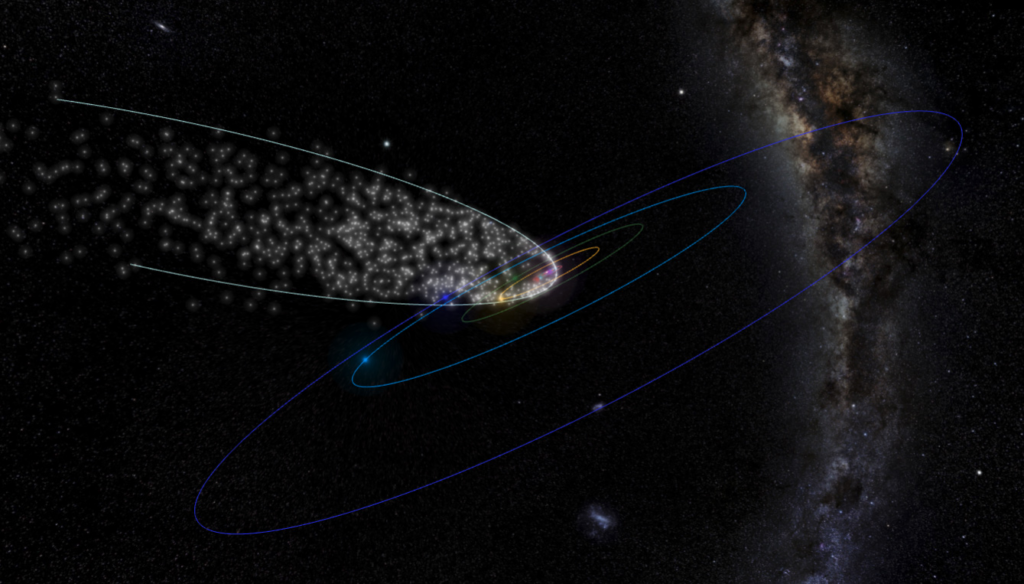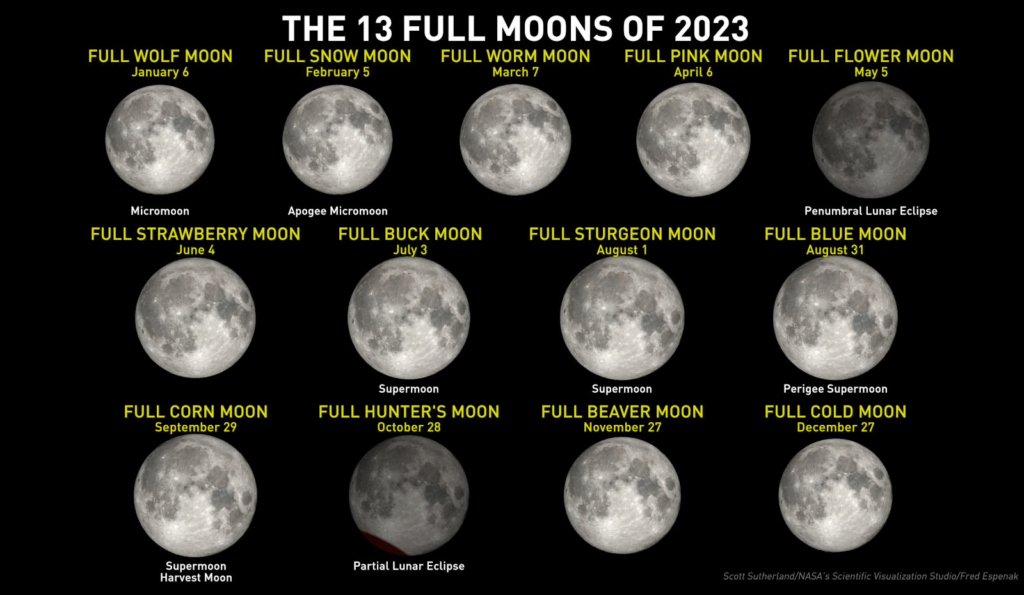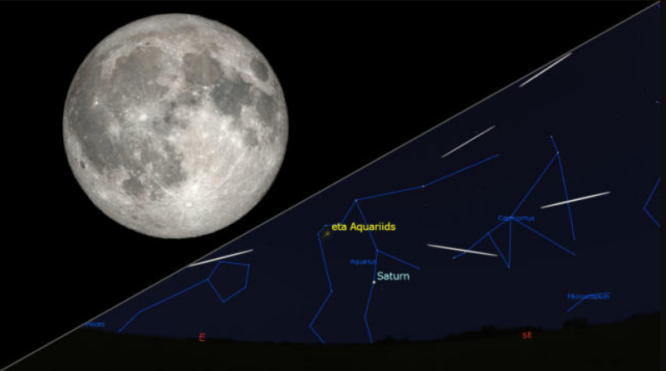This week, see the Full Flower Moon with what may be the finest eta Aquariid meteor shower in years.
Earth travels through Halley’s Comet’s ice and dust from late April to May. The eta Aquariids meteor shower, occurring from April 19 to May 28, peaks on May 5 and 6 in 2023.
Eta Aquariids are best seen before dawn on May 5 and 6. The radiant—the spot in the sky where meteors appear to radiate—rises above the eastern horizon.
Under ideal conditions—a clear, dark sky with the meteor shower radiant overhead—the eta Aquariids produce about 50 meteors per hour. Most viewers will see half that number, and strong moonlight may reduce it more.
This year’s eta Aquariids has an intriguing twist.
The International Meteor Organization predicts more meteors than typical near the meteor shower’s peak due to a somewhat thicker area of Comet Halley’s debris track.
The IMO advises looking for increased activity on May 4, 5, and 6 mornings, though it can’t predict how much. Enhanced activity may offset the Moon’s bright light.

Persistent Trains!
Due to their speed, the eta Aquariids create a unique phenomenon.
Comet Halley meteoroids cause short meteor flashes at 240,000 km/h. If you look attentively, you may observe another phenomena. Some meteors leave a luminous trail that can float for minutes or hours. Persistent trains

What’s a persistent train?
Trains seldom persist. Thus, scientists are still trying to determine their cause, but they have two leading theories.
First, meteoroids move fast enough to take electrons from air molecules, ionizing them. Air molecules capture stray electrons and emit light energy. The ‘train’ is fainter and lasts longer than the meteor flare because this process takes longer.
‘Chemiluminescence’ is the other idea. Metals vaporizing off a fast-moving meteoroid can chemically react with air ozone and oxygen to light.
One or all of these hypotheses may explain persistent trains. More sightings will explain these.
Full Flower Moon/Penumbral Lunar Eclipse
Friday, May 5, is the Full Moon at 1:35 p.m. EDT. NASA predicts the Moon will be full from early Thursday morning until early Sunday morning on May 4–6.

This is the Full Flower Moon.
“The May Full Moon is known as Flower Moon to signify the flowers that bloom during this month,” says TimeandDate.com. Old English/Anglo-Saxon titles for the May Full Moon include Corn Planting Moon and Milk Moon.
This year marks the third consecutive May Full Moon lunar eclipse.
2021 and 2022 super total lunar eclipses. Thus, they both occurred when the Moon was closer to Earth than usual (‘super’) and passed directly through the dark center of Earth’s shadow (the ‘umbra’), turning the Moon’s surface red.
This year will be harder to see.
First, you’d have to go across the globe to see it. North America will only see it from the Hawaiian Islands and the Andreanof and Rat Islands in the North Pacific west of Alaska.
Second, since this is a penumbral lunar eclipse, the Moon won’t change much.

A penumbral eclipse just passes across Earth’s shadow’s faint border, unlike a total lunar eclipse. The Moon’s reflected light will only decrease somewhat during maximum eclipse.
Meteor shower tips
Meteor showers are widely viewed. Equipment isn’t needed. Binoculars and telescopes narrow your vision, making meteor showers difficult to spot. To avoid missing these fantastic events, keep a few things in mind.
Three-night sky observation tips are:
Check weather,
Avoid light pollution and
Be patient.
Clear skies are crucial. Cloudy skies can impair meteor shower viewing for even a few hours. To get the latest sky forecast, visit The Weather Network on TV, our website, or our app, and search for my Space News stories.
Next, avoid city lights. What’s in the sky from home? Moon, planets, brilliant stars like Vega, Betelgeuse, and Procyon, and airliners? If so, light pollution prevents you from enjoying a meteor shower. If a brilliant fireball passes overhead, you’ll probably just see it. To maximize stargazing and meteor watching, leave the city. More distance is preferable.
In much of Canada, you may escape light pollution by driving beyond your city, town, or hamlet until you can see many stars.
Southern Ontario and the St. Lawrence River have too much light pollution. Leaving one city’s light pollution puts you under the next city’s dome. Location determines light-blocking alternatives. Lake Erie offers great vistas in southern Ontario and the Niagara Peninsula. Drive north to Ontario or Quebec provincial parks in the GTA and east. Even if you’re stuck in the parking lot after hours, these are great spots to view (and you won’t trespass).
If you can’t escape, the suburbs may provide a prettier night sky. Limit direct light in your range of view. Your greatest refuge is dark backyards hidden from street lights by adjacent houses and trees. The movie above shows sky views dependent on light pollution. Find local dark sky preserves.

Check the Moon phase before seeing a meteor shower. Meteor showers are best seen during New or Crescent Moons. A Gibbous or Full Moon may obscure all but the brightest meteors. Since we can’t avoid the Moon, time your outing so it’s set or low in the sky. To avoid seeing the Moon, slant your gaze. This reduces its effect on night vision and lets you see more meteors.
After confirming clear sky and minimizing light pollution, be patient.
Your eyes must adjust to the dark before viewing. Give your eyes 20–45 minutes to adjust to bright light.
This is perhaps the worst letdown while witnessing a meteor shower.
From a well-lit residence, you could see a rare brilliant fireball meteor. You’ll probably see nothing. Our eyes must adapt to see meteors racing overhead. Avoiding streetlights, automobile headlights and interior lights, and smartphone screens for at least 20 minutes greatly boosts your chances of not being disappointed.
Smartphones are sometimes necessary. In this situation, lower the screen’s brightness and blue light. Thus, your night vision will be less affected.
While your eyes adjust, look at the stars. As you adjust to the dark, you may see some brighter meteors.

